Rivers with natural vegetation along their banks are special spaces that for some may evoke spiritual responses and notions of the sacred. Even when rivers are dry the riverine vegetation retains a sheltering and nurturing power.
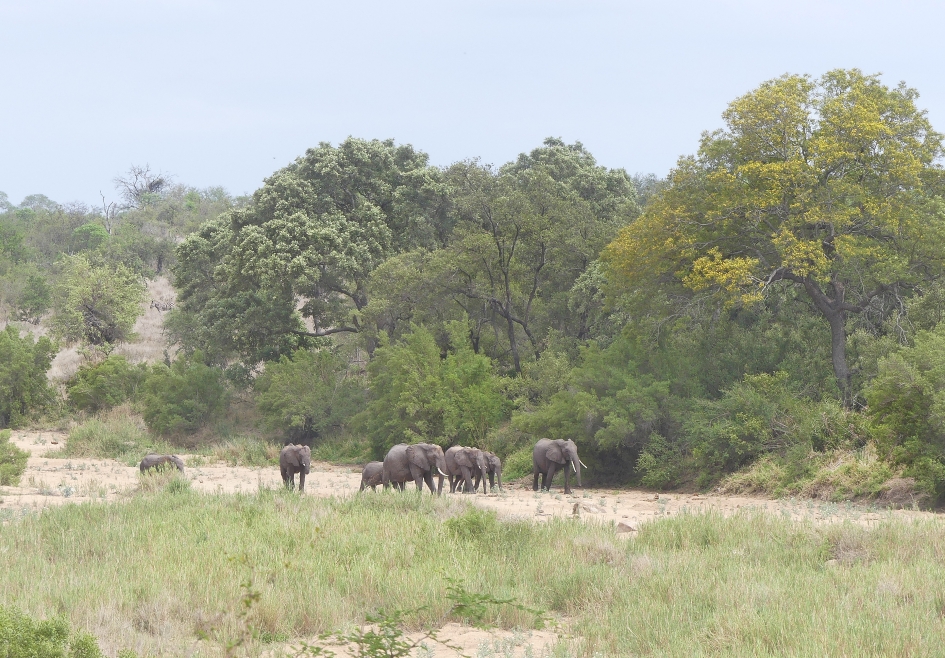
Almost like a mirage in the heat, elephants make their way along the dry riverbed of the Timbavati River in the Kruger National Park. Large riverine trees line the far bank.
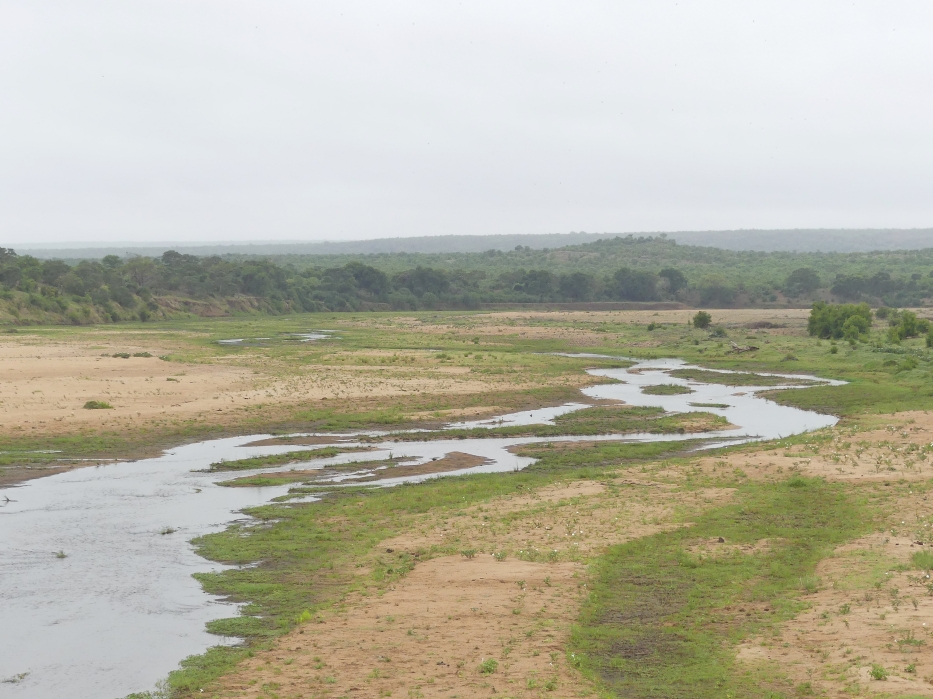
Water flowing in a particularly wide section of the Letaba River loops lazily across the sandy riverbed. This was in November and only a little summer rain had fallen so far in the vicinity of the Letaba Rest Camp. The Letaba is one of the few perennial rivers that flows through the Kruger National Park.

Above is another view of the Letaba River in the same region of the park. Here the river flows in two main channels. In the ground between the channels waterbuck (Kobus ellipsiprymnus) and impala (Aepyceros melampus) are grazing accompanied by western cattle egrets (Bulbulcus ibis). The banks are lushly vegetated with riverine trees and shrubs.

A juvenile fish eagle (Haliaeetus vocifer) ruffles its feathers prior to taking off from its perch in a dead tree on the banks of the Letaba River.
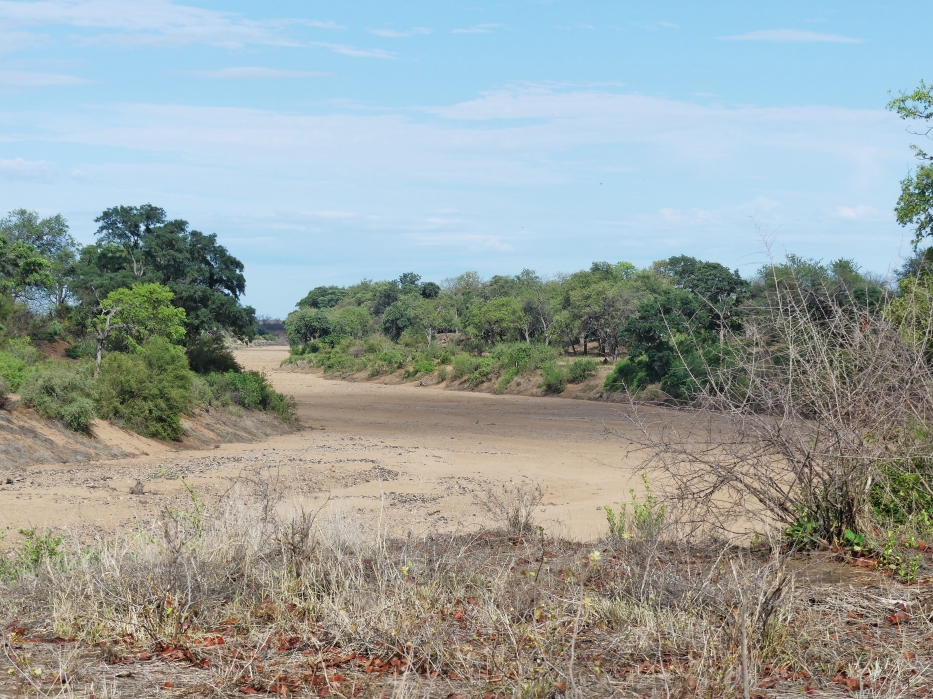
Further north, although the Mphongolo River was dry, its rich and wide band of riverine woodland was characterised by large trees and shrubby vegetation that provided food and shelter for a variety of animals and birds. The Mphongolo River is dry for most of the year although some pools are fairly permanent.

From our vantage point on the high river bank we could see downstream a couple of pools of water against the banks. Some of the pools are much more substantial than these and are large and deep enough to accommodate small numbers of hippos.

A rockier section of the Mphongolo River contains enough water to provide a pool for a small pod of about seven hippos.
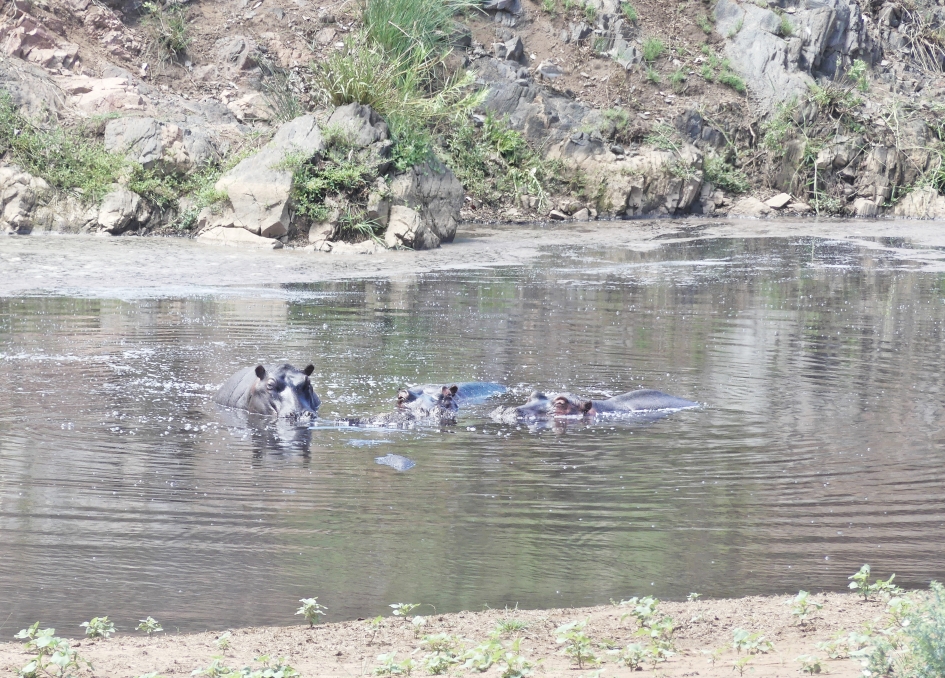
Above is a closer view of some of the hippos (Hippopotamus amphibius capensis) in the pool. They were surprisingly active perhaps as they kept an eye on us viewing them from our car on a high section of the river bank.

A tree squirrel (Paraxerus cepapi cepapi), while grooming the tip of its tail, watched us from the enormous roots of an nyala tree (Xanthocercis zambesiaca) on the banks of the Mphongolo River, not far from the Sirheni Bushveld Camp.
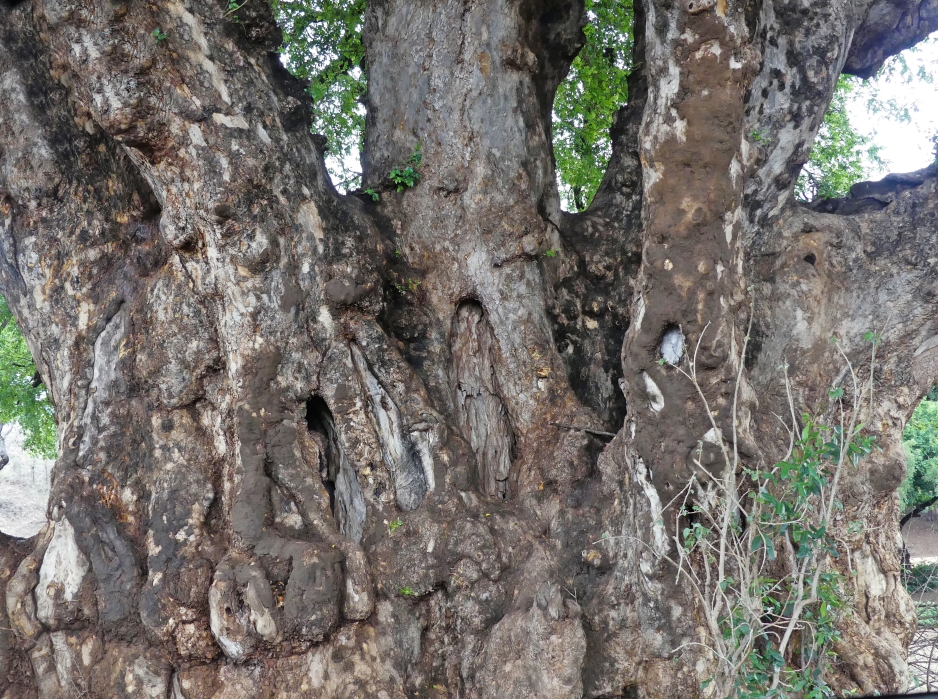
Further up the trunk of the same nyala tree, dry muddy deposits from where elephants have rubbed themselves on the gnarled trunk are visible.
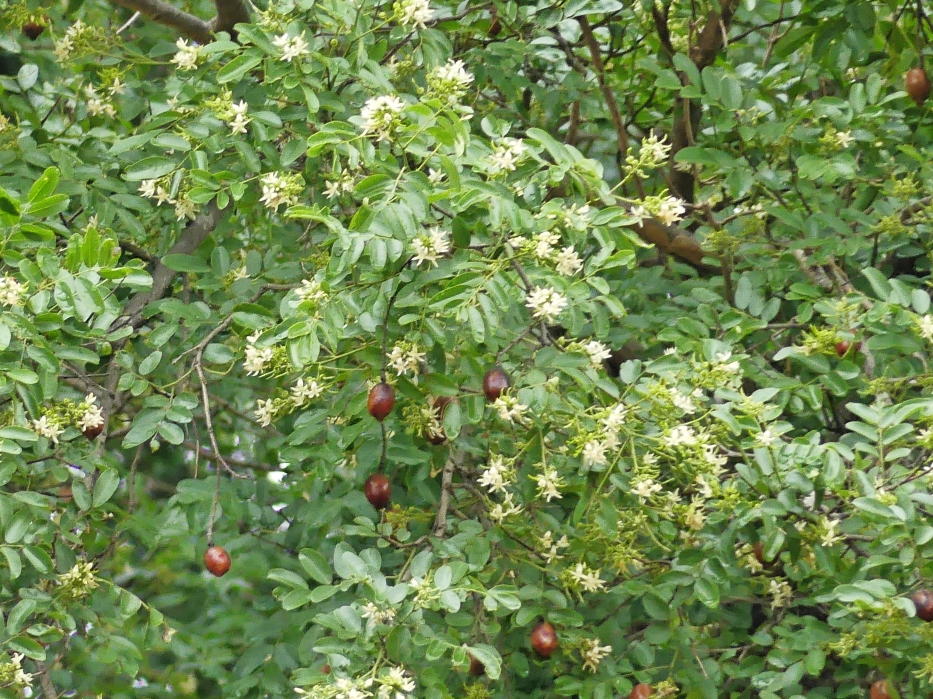
The nyala tree was in flower and bearing fruits at the same time. I was particularly thrilled on our visit to Kruger National Park to see the beautiful and imposing nyala trees as they are absent in my home province.
However I am accustomed to seeing the nyala antelope, which bears the same name as the tree, as they occur in conservation areas in the more north-eastern regions of KwaZulu-Natal. The antelope is named nyala in several African languages and the same name is adopted in English. The tree gets its colloquial name due to the fact that nyala antelope – in regions such is in the north of Kruger National Park where the antelope and trees coexist – like to eat the fallen berries.
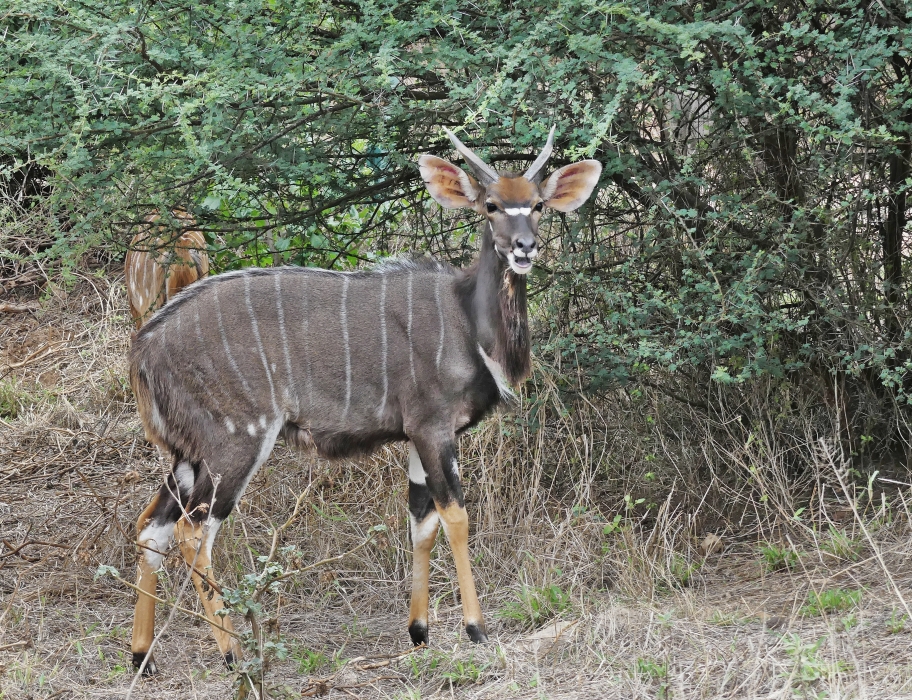
The photo above is of a young nyala antelope (Tragelaphus angasii) ram. He is old enough to have the dark body colour and fringes of long hair of an adult male but his horns still have quite a long way to go to grow longer and curve inwards towards the tips. This one was photographed near the Luvuvu River in the very north of the Kruger National Park. A female can just be seen behind him.
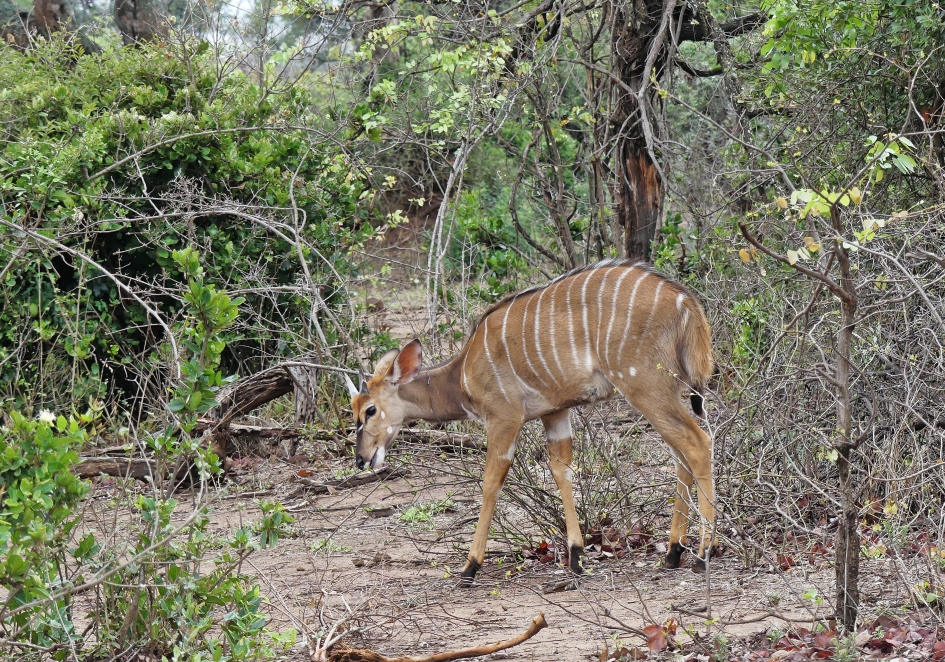
When at the Mphongolo River we saw an even younger male nyala that was starting to sprout his horns but was only just starting to subtly change to the darker coat colouration.
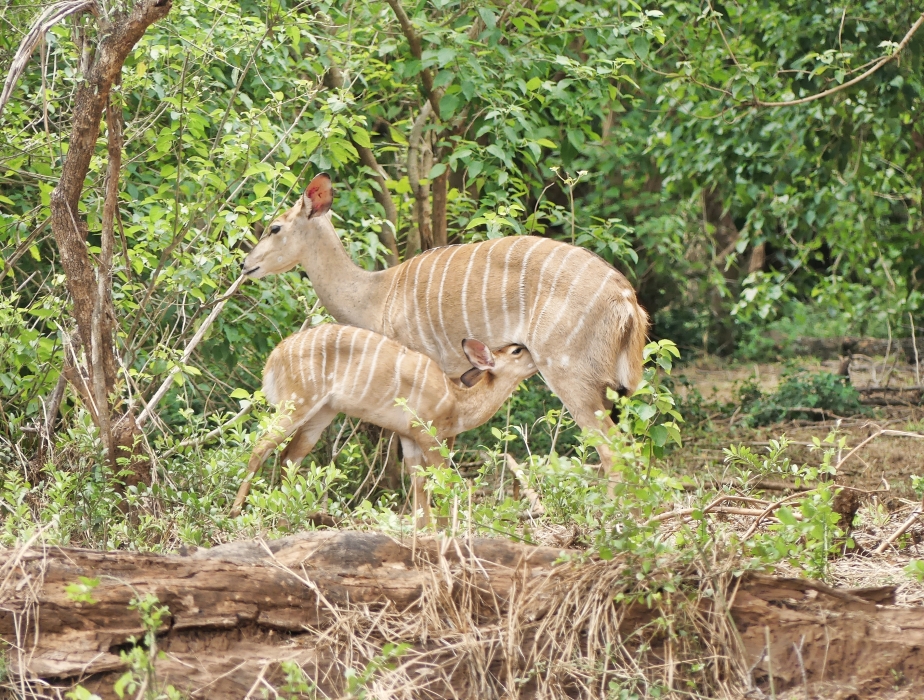
Also at the Mphongolo River, we saw a female nyala suckling her calf in fairly dense riverine vegetation. Young nyala males look the same as the females until they start growing horns and eventually attain the darker coloured coat, which happens when they are about four years old.
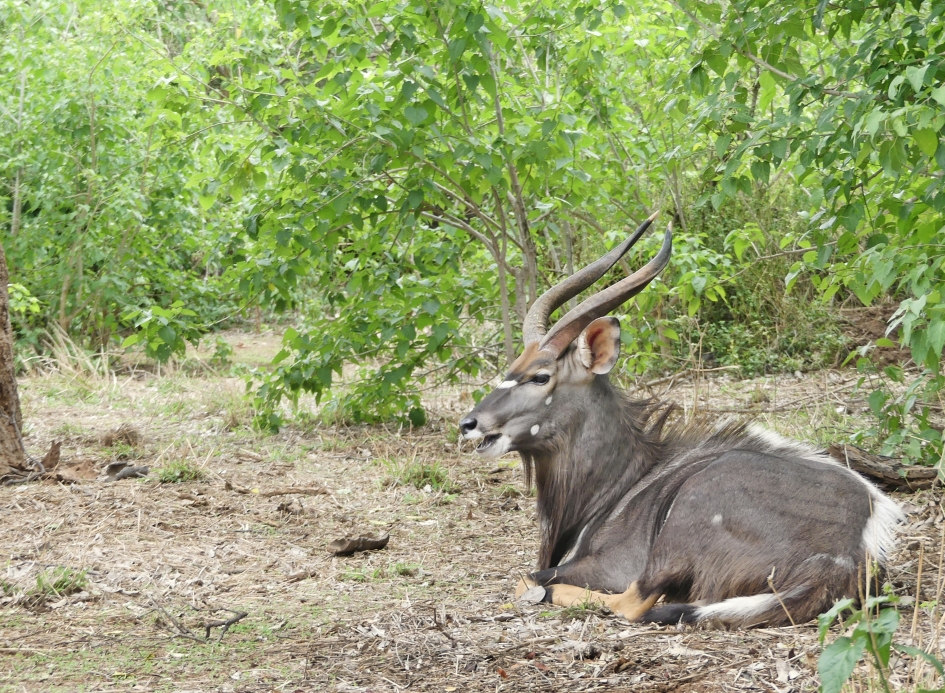
A mature nyala ram looking meditative while lying down to chew the cud. Another male nearby was doing the same.

Also in a stand of fever berry trees (Croton megalobotrys), we saw white-fronted bee-eaters (Merops bullockoides) hawking insects from their perches. White-fronted bee-eaters are gregarious and are commonly associated with riverine habitats. Typically they make their nesting burrows in the sandy banks of rivers or erosion gullies.
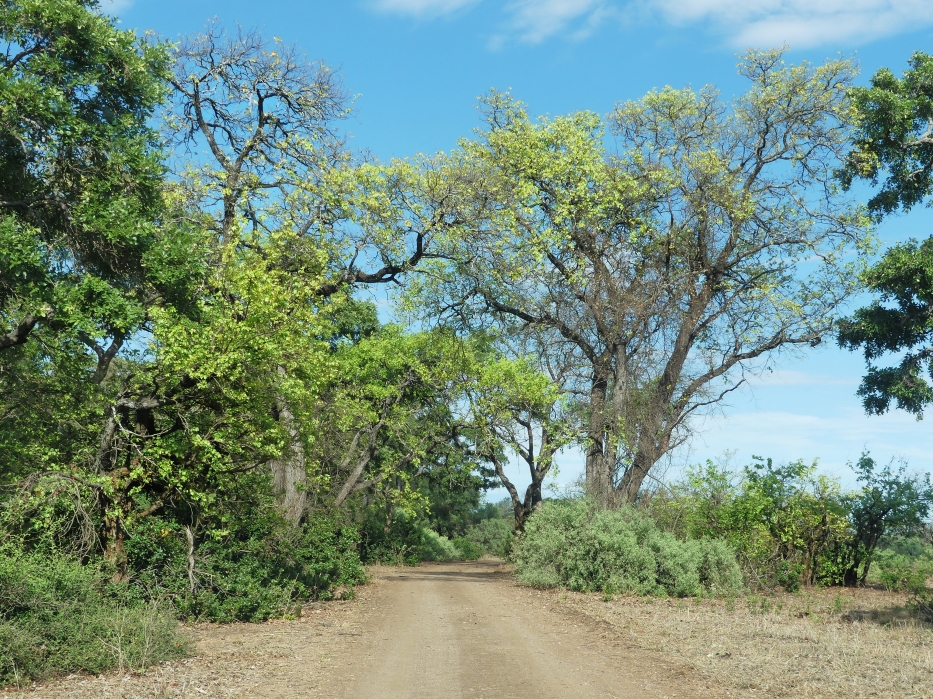
The lovely drive along the northern bank of the Mphongolo River is along the stretch of river that flows more or less between Sirheni Bushveld Camp and Shingwedzi Rest Camp. Above is a view of tall trees, including mopane trees (Colophospermum mopane), overarching a section of the road.
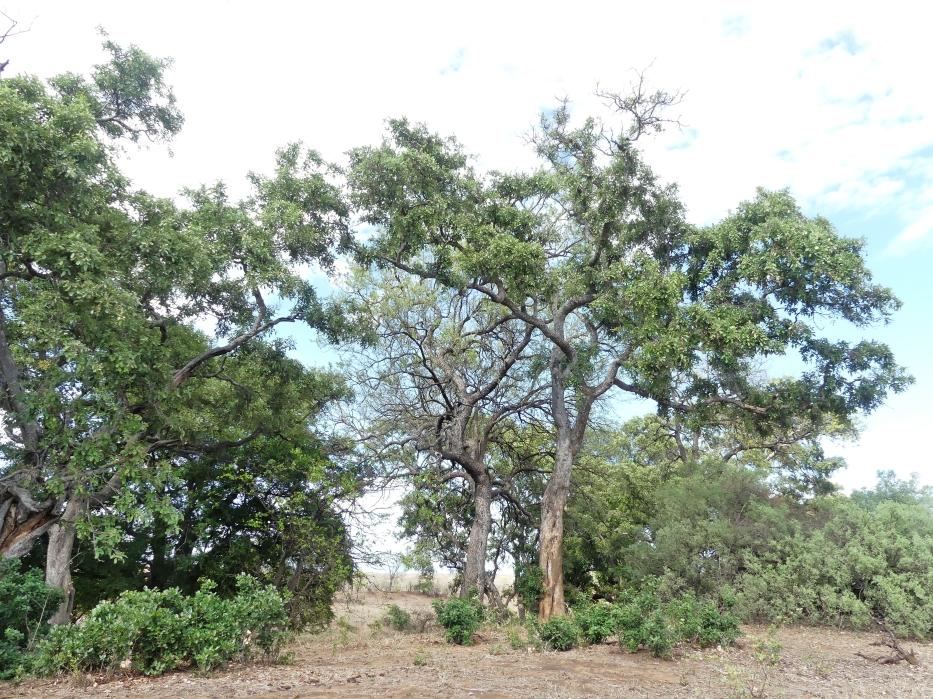
Above is another view of riverine trees that we saw along the Mphongolo River banks. The prominent trees here are apple-leaf trees (Philenoptera violacea). These trees may grow as tall as 20 metres. In KwaZulu-Natal they only occur in a tiny corner in the north bordering Swaziland and a sliver of Mozambique, so for me like the nyala tree they are unfamiliar and have an aura of exoticism although they are relatively common in the more northern parts of the country. In fact their distribution extends across tropical Africa. The northern section of Kruger National Park itself falls into the Tropic of Capricorn.

A view looking ‘upstream’ should the Mphongolo River be flowing. Many animal tracks crisscross the sandy river bed and at one point we spied on two elephants that crossed the river to browse on the other side.
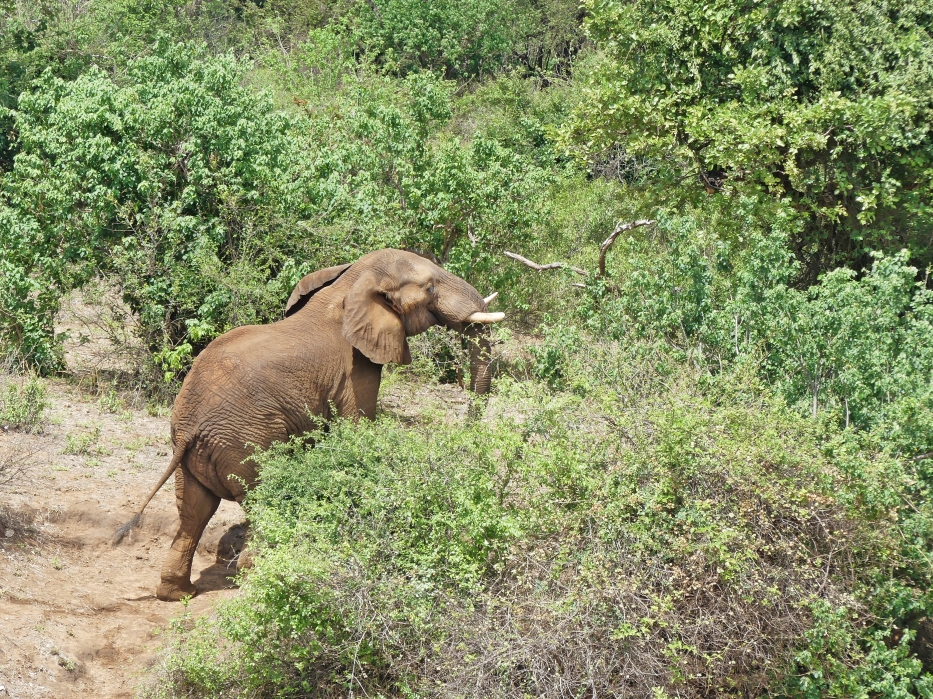
Having crossed the river and climbed up the river bank one of the elephants (Loxodonta Africana) turns to move parallel to the river to browse on the leaves of the riverine shrubs and trees. Not far from here we saw a small group of men in camouflage uniforms carrying rifles – they were anti-poaching rangers out on a patrol and a sobering reminder that even deep within the Kruger National Park rhinos and elephants are killed for the international trade in rhino horns and elephant tusks.

This was one of a jaunty group of greater blue-eared starlings (Lamprotornis chalybaeus) providing splashes of iridescent blue among the greens and browns of the riverine zone.
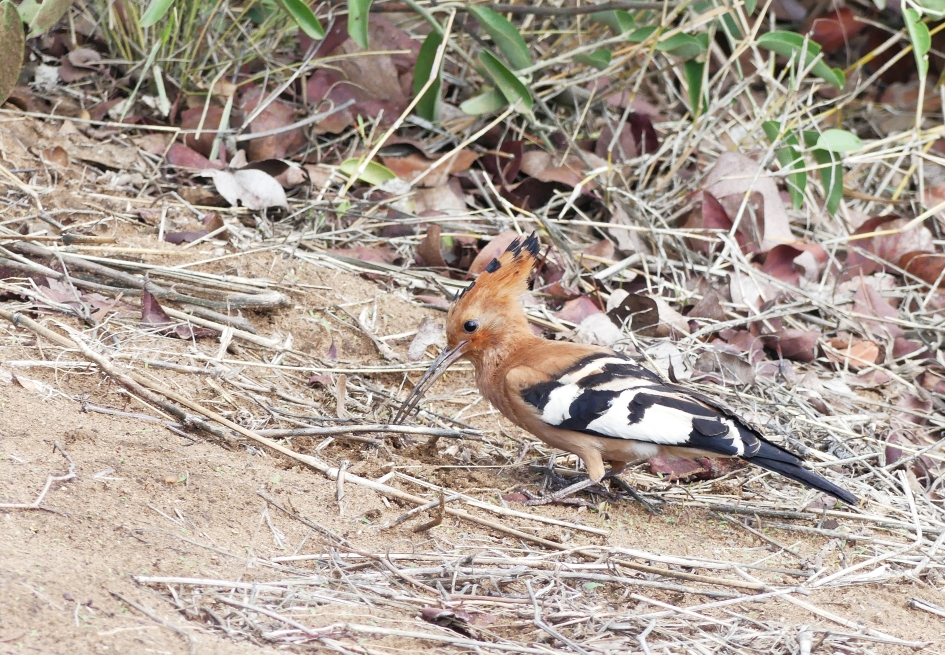
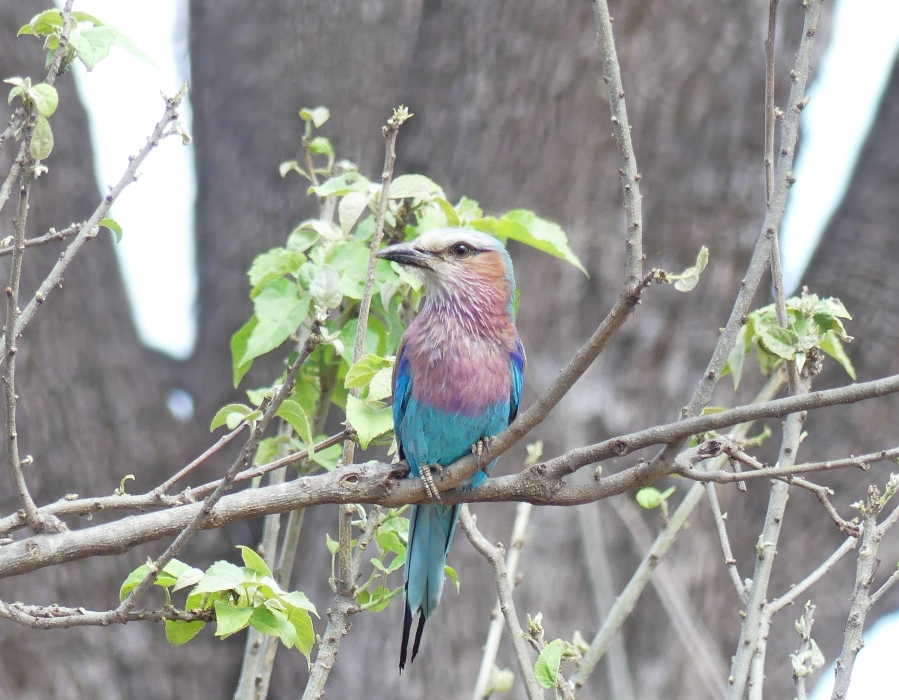
Perching for just long enough to be photographed in between swooping off to hunt for insects, this lilac-breasted roller (Coracias caudatus) was eye-catching.

These young impala were part of a larger group near the road where lower ground behind them sloped down to the river.

It is impossible not to be captivated by the innocent expressiveness of baby impalas.

Above is another substantial pool in a bend in the Mphongolo river in a rockier section where the riverine trees are not so large and the vegetation is less dense. Against the right-hand bank the exposed back of a hippo can be seen.

In fact there were two hippo there but the one to the left spent most of its time submerged.
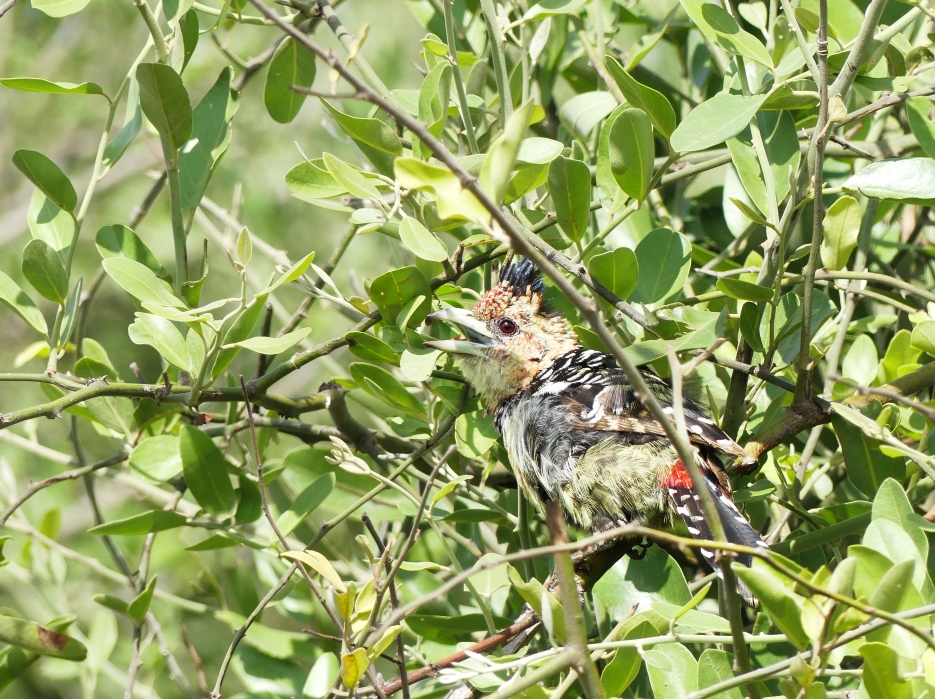
This crested barbet (Trachyphonus vaillantii) felt sufficiently concealed to indulge in some sunbathing where we spotted it near a bend in the road along the banks of the Mphongolo River.
I apologise for being somewhat absent from the blogosphere lately and for posting this a week behind schedule. Like many of us I have felt overwhelmed by world events.

I am ending this post on the hopeful note of a river sunrise.
Posted by Carol






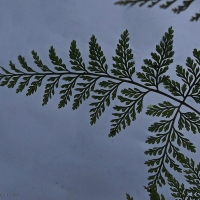
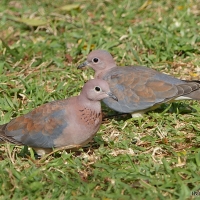
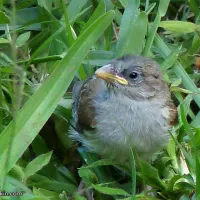
March 25, 2022 at 2:52 am
So many wonderful encounters, Carol, thank you for sharing. The antelope are so incredibly elegant, and I would be dancing were I to see a bee-eater, roller, and hoopoe all in one day. 🙂
I can relate to how you feel about world events, and know that many others feel the same.
Hoping and wishing for peace,
Tanja
LikeLiked by 1 person
March 25, 2022 at 8:42 pm
Thanks Tanja. Those three birds are especially beautiful and charismatic. Memories of such encounters can help sustain us.
Joining you in hoping and wishing for peace.
LikeLiked by 1 person
March 22, 2022 at 9:22 pm
Thank you for the safari.
LikeLiked by 1 person
March 7, 2022 at 12:07 pm
Thank you for the marvellous virtual trip Carol.
LikeLiked by 1 person
March 8, 2022 at 7:05 pm
Glad you enjoyed it Christine 🙂 It was nice to relive it while putting the post together.
LikeLike
March 6, 2022 at 9:17 pm
It almost felt as if I was in the KNP through the magic of your photographs. Thank you too for the informative text
LikeLiked by 1 person
March 8, 2022 at 7:02 pm
Thanks Mariss. The riverine areas are always so rich.
LikeLiked by 1 person
March 6, 2022 at 9:43 am
Lovely post Carol, and I enjoyed learning about a part of KNP that I have not seen before. There were so many trees that are new to me. The photos of the birds are lovely! I just cannot seem to get a good clear image of a Lilac Breasted Roller, and your is lovely. Your comment on the baby Impala is so true! Your final photo is stunning!
LikeLiked by 1 person
March 6, 2022 at 8:25 pm
The trees are astounding. At times I felt quite frustrated as I did not have the means to identify some really impressive species, but at least I managed to learn to recognize two or three species that were unfamiliar. (Some of the camps had labelled trees and that helped!)
I am always pleased if I manage to get a half-decent pic of a roller as they can be so flighty.
I never tire of seeing baby impalas – or baby anything for that matter – but impalas are a favourite.
LikeLiked by 1 person
March 13, 2022 at 4:15 am
It is surprising too, when plant names pop into your head (memories from long ago) when you are staring at a plant, thinking, I should know this……and then you realise you are correct! This does not happen as often enough as I would like! 😉
LikeLiked by 1 person
March 6, 2022 at 6:24 am
Lovely photos, Carol and a great description of the ecosystem in that area. And no need to apologize for being appalled by the state of the world right now. It’s be depressing for any reasonable human being.
LikeLiked by 1 person
March 6, 2022 at 8:20 pm
Thanks Graham.
Appalling and depressing pretty much sums it up.
Sending best wishes from SA.
LikeLiked by 1 person
March 5, 2022 at 7:17 am
A wonderful trip! So much beauty!
LikeLiked by 1 person
March 5, 2022 at 8:04 pm
Thanks Simone – it was a wonderful trip and there was so much beauty to see and enjoy.
LikeLiked by 1 person
March 5, 2022 at 5:28 am
Yes, I agree, rivers are sacred places, nourishing both life and spirit. Thank you Carol for your beauty-filled account and insights! xxx
LikeLiked by 1 person
March 5, 2022 at 8:04 pm
I am glad that rivers are also special places for you Christeen 🙂 They really do draw one in.
xxx
LikeLiked by 1 person
March 5, 2022 at 4:08 am
You’ve really tugged at my heart strings with your beautiful images of familiar views from the northern Kruger Park. Thank you, Carol.
LikeLiked by 1 person
March 5, 2022 at 8:01 pm
Hi Dries, nice to know that these views are familiar to you and you recognized them in my photos. For us it was our first time there and so very fresh. We enjoyed seeing the gorgeous trees and learning to identify some new ones (not that we learnt them all by a long way!).
LikeLike
March 5, 2022 at 1:30 am
Beautiful photos, Carol. You must have a very long lens! I loved the stripes on the nyala, great camouflage allowing them to blend in with light and shadow, I imagine. And clearly, the impala are the runway models of the bush with those long, thin legs!
LikeLiked by 1 person
March 5, 2022 at 7:59 pm
I love your description of the lovely leggy impalas 🙂 The stripes on the nyala are beautiful and I imagine they do break-up the shape and serve as camouflage.
I use a bridge camera (Panasonic Lumix) – although it has its limitations it is versatile and easy to use and the zoom lens is very handy for the sort of photography I do.
LikeLiked by 1 person
March 4, 2022 at 10:21 pm
It’s so difficult to remain positive these days, but I am grateful for posts like yours that remind us of the wonders of nature, while also being honest about how desperate these times are. Better to light a single candle….. 😗
Be well,
Julie
LikeLiked by 1 person
March 5, 2022 at 7:55 pm
It is indeed difficult, but that notion of lighting a candle is a useful one, thanks. Some time back I had the idea that the quote was its better to light a candle ‘than be overwhelmed by the darkness’, but then I found out that in fact it is ‘than curse the darkness’, but I suppose the imperative remains the same and it is sage advice.
I hope that all is well with you too.
LikeLiked by 1 person
March 4, 2022 at 6:43 pm
There is never a need to apologise for not posting. Besides, when you treat us to such a feast of beautiful photographs and interesting information delivered in your inimitable style, the wait is well worth it!
LikeLiked by 1 person
March 5, 2022 at 7:46 pm
Thanks for your very kind comment Anne.
LikeLike
March 4, 2022 at 5:05 pm
Yup! World events leave us with a feeling of desperation.
LikeLiked by 1 person
March 5, 2022 at 7:45 pm
Yes the situation does feel desperate and the ramifications are likely to be immense. But we need to keep on keeping on where we can …
LikeLike
March 4, 2022 at 3:16 pm
Overwhelming indeed. But a bit of self-care comes from focussing on a post like this one. I’m astonished at the variety you show here. At first I thought it was going to be an area of total lushness, But though there is indeed a lot of vegetation, the ground itself seems quite arid. But there’s certainly plenty going on!
LikeLiked by 1 person
March 5, 2022 at 7:43 pm
Yes you are right, even when overwhelmed we do need to try to distract ourselves with something comforting if at all possible.
There are strange dichotomies in semi-arid regions where there is huge diversity even in aridity and of course the rivers provide corridors of vegetation even when the river beds are dry. It is amazing how much there is going on!
LikeLike